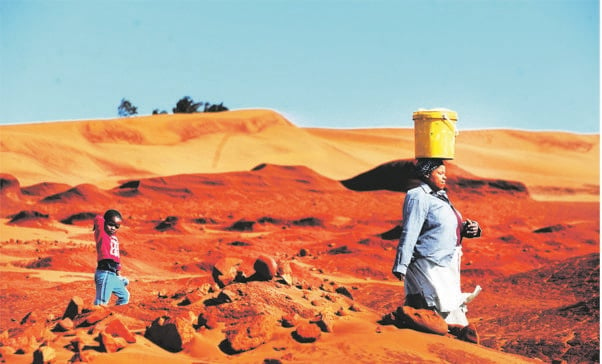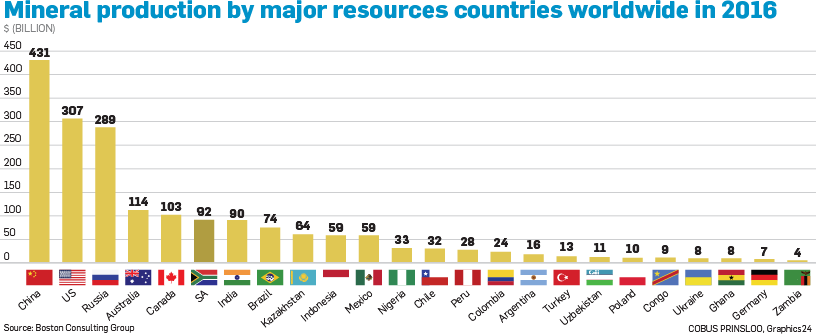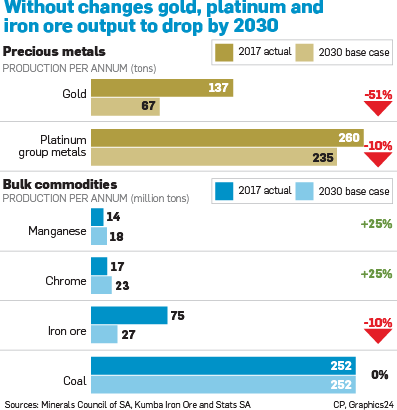
Mining competitiveness report projects that mechanisation could result in an extra R71bn in revenue and 52 000 jobs being saved by 2030
Mining Minister Gwede Mantashe last week reiterated his intentions to push ahead with efforts to determine whether there would be mining at Xolobeni in the Wild Coast region of the Eastern Cape.
“What we want to do is engage the community of Xolobeni, which we have done,” he said during a media conference at the African Mining Indaba, which took place in Cape Town from February 4 to 7.
“A person made the comment that we are here for the third time. ‘It has never happened, Minister,’ that person said. ‘Ministers used to come here. They get a hard time and they disappear forever. They never come,’” Mantashe said.
“I replied that I want to be here [in Xolobeni] 10 times until the Xolobeni issue is resolved. We cannot have the Xolobeni issue on the table from 2002 until now and keep it hanging all the time … We cannot keep it hanging for more years now.”
Mantashe has mantained that the community of Xolobeni needs mining in order to bring development in the area this despite a court ruling in November that his department must obtain consent from the Xolobeni community before giving mining rights to any mining company seeking to operate there.
Mantashe said that at Xolobeni the process of awarding mining rights had been stopped. “As we sit here today, there is no company that has access to mining.”
Australian company Mineral Commodities, which trades on the Australian Securities Exchange as MRC, has applied for prospecting and mining rights in Xolobeni, but will have to wait until the moratorium on the processing of applications for that area is lifted.
MRC is looking to mine titanium in the area.
It currently operates the Tormin mineral sands mine near Vredendal on the West Coast.
At last week’s mining indaba, Mantashe told journalists that he would visit the Tormin mine: “We are going there to do an on-site inspection of operations, and ask these questions: Is it a compliant company? Is it a good mining company? Does it respect environmental and other requirements?
“It will be a fact-finding visit to Vredendal. This is all part of developing a mechanism to make a decision.”
The Centre for Environmental Rights (CER) last week urged Mantashe to take note of MRC’s coordinated campaign of litigation against activists, lawyers and the media to silence criticism of the company and its operations.
“MRC and its subsidiaries have sued community activists, environmental attorneys, a social worker, a journalist and a local West Coast newspaper for defamation claims amounting to more than R9 million,” the CER said.
And, in a letter addressed to Mantashe, the centre’s executive director, Melissa Fourie, wrote that MRC had a track record of noncompliance at the Tormin mine.
With regard to the contribution made by the mining sector to the local economy, Mantashe said he would like to see this increase from 7% of GDP to 10% over the next three to five years. However, he provided no details on how this could happen.
He made mention of a study, conducted by the Council for Geoscience (CGS), whereby a new gold deposit, “which has not been touched”, had been discovered. “Through the work of the CGS, a rich orebody of gold has been discovered to the east of Vredefort, in the Free State.”
In a similar vein, global management consulting firm the Boston Consulting Group (BCG) released a report on the sidelines of the mining indaba, looking at how to halt the decline in South Africa’s mining sector that has been taking place over the past 20 years.
The report recommends a number of interventions that could potentially result in an extra R71 billion in revenue and save up to 52 000 jobs by 2030.
When it comes to gold, the BCG report recommends that research be conducted into implementing mechanisation. It projects that mechanising the sector could save as many as 22 000 jobs by 2030 – and for platinum, this could save about 4 000 jobs by 2030.
“Our base case, without intervention, could potentially result in a reduction of revenue of R28 billion and the loss of 68 000 jobs by 2030, relative to 2017 levels,” says the report.
According to the BCG’s baseline forecast – used to outline future energy demand under a business-as-usual scenario, and to show where opportunities lie for energy savings and environmental improvement – by 2030, South Africa’s gold output will fall by almost half to just 67 tons, from 137 tons in 2017.
According to the forecast, platinum group metal output is expected to drop by 10% and iron ore output by 64%. Coal production will be maintained, while manganese and chrome output will increase by 2030.
In its upside 2030 scenario, the BCG projects that if platinum and gold mines are mechanised, it will slow down the decline in output. In addition, improved infrastructure will boost the output of manganese, chrome and coal by 2030.
The BCG report examines the state of the mining industry since 2009.
Among its findings are that social indicators in the sector – such as empowerment, wage levels, safety, working conditions, skills advancement and community investments – have improved across the board.
In addition, it says, mineral sales, industry output and industry market capitalisation have all been largely stable since 2009.
However, employment, direct mining investment, the sector’s real GDP contribution and its relative contribution to the local economy have all declined since 2009.
The BCG study has assessed South Africa’s mining competitiveness as weak, citing factors such as poor government regulation, energy costs, the unreliability of energy supply, poor water availability, inefficient logistics, issues with information and communication technology, and difficult labour conditions.
The report identifies growth constraints for most of South Africa’s major minerals.
It also points to rail infrastructure and water constraints in the Waterberg area, in Limpopo, hampering coal mining there.
It points out that iron ore requires large-scale developments to maintain mining, and that rail infrastructure needs to be expanded to allow for greater exports.
The country lags behind many peer countries in terms of exploration and technological innovation.
“South Africa’s spending on exploration is the lowest among leading mining countries. Its share of the global exploration budget … fell from 1.6% in 2009 to 1.1% in 2017.”
In the gold-mining sector, the report finds that South Africa has the highest labour cost-per-ounce produced among the 10 largest gold-producing countries.
In another development, Mantashe announced the state was planning to have separate laws governing the mining and petroleum sectors. Currently, the Mineral and Petroleum Resources Development Act covers both the mining and petroleum industries.
On corruption at the Department of Mineral Resources regional offices, Mantashe said that four regional offices had been audited.
“That’s Mpumalanga, Limpopo, the North West, and the Northern Cape. We are hoping to be able to audit all of them. We are have picked up a number of things.”
“We picked up properties that did not exist…We are serious about uncovering that corruption. In one province a health and safety inspector was caught selling Section 54. We caught him out and you can’t sell safety. That man is no longer in the department now.”




 Publications
Publications
 Partners
Partners










